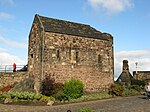Scottish National War Memorial

The Scottish National War Memorial is located in Edinburgh Castle and commemorates Scottish service personnel and civilians, and those serving with Scottish regiments, who died in the two world wars and subsequent conflicts. Its chief architect was Robert Lorimer, commissioned in 1919, and the monument was formally opened in 1927. It is housed in a redeveloped barrack block in Crown Square, at the heart of the castle, and incorporates numerous monuments. The Rolls of Honour kept in the memorial include the names of those Scots servicemen and women and Scots civilians that died in all wars after 1914. This includes all Scots who were killed as a result of enemy action or who died as a result of wounds, diseases, or injuries while serving in the British Armed Forces, the Merchant Navy, the armed forces of the Dominions, the women's services, and the nursing services, together with all members of Scottish regiments. The Rolls of Honour include those who died between 4 August 1914 and 31 August 1921 as having died in the First World War and those between 3 September 1939 and 31 December 1947 as having died in the Second World War. Those not serving in the Scottish regiments must either have been born in Scotland or have at least one parent born in the country.The memorial rolls list close to 135,000 casualties of the First World War and over 50,000 of the Second World War. More casualties from later wars are also inscribed, including from the Malayan Emergency, the Korean War (1950–1953), Operation Banner (1969–2007) during The Troubles, the Falklands War (1982), and the Gulf War (1990–1991).
Excerpt from the Wikipedia article Scottish National War Memorial (License: CC BY-SA 3.0, Authors, Images).Scottish National War Memorial
Castlehill, City of Edinburgh Old Town
Geographical coordinates (GPS) Address Phone number Website Nearby Places Show on map
Geographical coordinates (GPS)
| Latitude | Longitude |
|---|---|
| N 55.9486 ° | E -3.2008 ° |
Address
Edinburgh Castle
Castlehill
EH1 2NG City of Edinburgh, Old Town
Scotland, United Kingdom
Open on Google Maps









